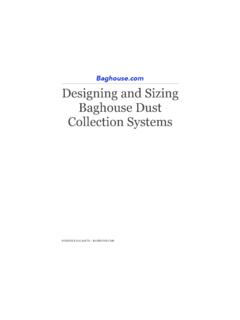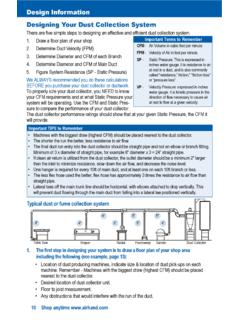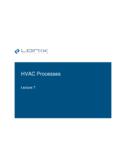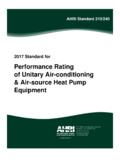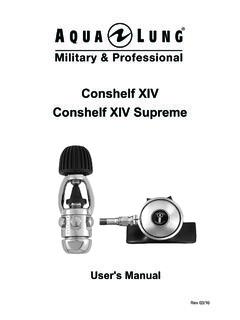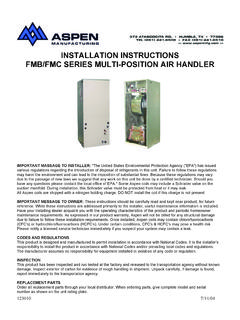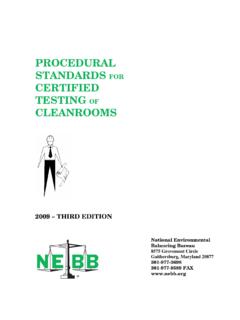Transcription of Designing and Sizing Baghouse Dust Collection …
1 Designing and Sizing Baghouse dust Collection Systems DOMINICK DALSANTO - B AGHOUSE . COM P RESENTS. How to Design and Size a Baghouse dust Collection System Guide to Designing your dust Collection system and avoiding the pitfalls of under- sized systems. By Dominick DalSanto Sales Director & Baghouse Expert Direct: (630) 984 5473. Office: (702) 848-3990. Email: I NTRODUCTION challenges due to improper system design and engineering. Many users rely on outside vendors or so-called experts with Purpose of This Guide little to no actual dust Collection experience to design and engi- neer a system for them. Other times vendors may purposefully K EY P OINTS OF THIS GUIDE undersize a system in order to undercut other potential suppli- ers regardless of how it actually performs in the end for their 1. Many So-called Baghouse Experts know little customer. Still others design their own system in-house think- about proper dust Collection design and operation ing it an easy process that just any engineer can accomplish 2.
2 OEMs and sales reps frequently undersize systems to with little to no outside guidance. These cases frequently end win contracts - Leaving customers with a system that with an inadequate dust Collection system that cannot meet does not work the needs of the process, resulting in high emissions, lowered productivity, hazardous work environments or all three! 3. Educated clients can determine the general size they need and use it as a basis to compare quotes So what can facilities do to ensure they do not encounter these same issues? In our experience, an educated user benefits the 4. Understanding principles of dust Collection system most and becomes best customer. With that in mind, we have design enables facilities to make better decisions prepared this guide to assist users in Designing and properly regarding Baghouse maintenance, operation and Sizing a dust Collection system.
3 By following the direction in safety this guide closely, you can effectively estimate what kind of system you require and then use this information as a basis dust Collection systems play a vital role in many commercial for gathering quotes and additional assistance. and industrial facilities. Whether part of a system process, used to capture harmful pollutants from furnaces/boilers, to This guide is NOT an exhaustive course on dust collector de- convey dry bulk product or to maintain a clean and safe work sign. Each system presents unique circumstances that affect environment, dust Collection systems need to function at near the general operation of a Baghouse system. As such, the constant peak efficiency for facilities to operate safely and pro- guidelines present in this guide should be used only to esti- ductively. mate the Sizing of your system. A qualified, and experienced dust Collection system OEM should be consulted before pur- While maintenance and proper operation play a large role in chasing any equipment or making design changes keeping these systems running properly, many facilities face 2.
4 S ECTION 1. The Four Key Baghouse System Design Variables For a dust Collection system to function ade- quately engineers must design and operate the system to maintain the (4) key design parameters of CFM, FPM, Vacuum Pressure and Air to Cloth Ratio (or A/C). Changes to any of these key sys- tem parameters will result in systemwide perform- ance issues. All four of these parameters are fluid and directly affect the others. Maintaining all at proper levels requires careful engineering, opera- tion and maintenance. Lets review these four parameters one by one. F OUR K EY B AGHOUSE D ESIGN P ARAMETERS Why Important? Airflow in CFM (Cubic Feet Without sufficient CFM the sources will not be vented ade- quately. Poor venting directly causes damage to equipment, per Minute) high emissions, loss of reclaimed product and hazardous envi- ronment (especially of concern in facilities handling combusti- ble dusts or hazardous materials).
5 Low CFM can also nega- W HAT I S IT ? tively affect air velocity, air to cloth ratio, and vacuum pressure, other key design parameters. 1. How much air the system moves is measured in Cubic L OREM Feet per Minute or CFM. Often, I PSUM. baghouses are sized using CFM. 1. Lorem ipsum dolor sit amet 2. In general, the larger the space being vented or 2. Consectetur adipisicing elit, sed do eiusmod the greater the number of pickup points in the tempor incididunt ut labore et dolore magna system the more CFM required. aliqua. 3. The CFM generated by the system fan can be 3. Ut enim ad minim veniam, quis exercitation fixed or adjusted (Variable Frequency Drive or ullamco laboris nisi ut aliquip ex commodo VFD Fans). However, total CFM generated by a consequat. fan can be affected changes in altitude, 4. ductwork Duis aute restrictions and irure dolor in in Sizing as well voluptate velitasesse resistance to flow cillum dolore created eu fugiat by pariatur.
6 Nulla the system (ductwork + filters). 4. F OUR K EY B AGHOUSE D ESIGN P ARAMETERS Why Important? Vacuum Pressure (Suction) If the vacuum pressure generated by the fan is not sufficient to overcome the static resistance of the ductwork and of the & Static Pressure (Static filters (called differential pressure or DP) several problems will arise. The system will suffer a loss of suction at the collec- Resistance) tion points (creating inadequate venting) and the air speed in the ductwork will drops causing product dropout (See section: W HAT I S I T ? Air Velocity: Why Important?). After the entire system is lay- out with equipment and ductwork connections mapped out 1. Vacuum pressure or suction is measured in the static pressure or static resistance must be calculated to de- inches of water gauge, and is the basis of a termine how much vacuum pressure is needed for the system properly functioning dust Collection system.
7 To function. 2. The system fan must supply enough suction to pull the materials from the Collection point(s). all the way through the ductwork to the Baghouse and then through the filters and out to exhaust. 3. To do that it must overcome the resistance to flow created by the filters and the ductwork. 4. Conversely, static pressure or static resistance is a measurement of resistance generated by the ductwork and the filters in Baghouse . This also is measured in inches of water gauge. 5. 5. F OUR K EY B AGHOUSE D ESIGN P ARAMETERS Why Important? Air Velocity and Minimum High air velocity can quickly wear holes the ductwork by means of abrasion (especially abrasive dusts like metals, ce- Conveying Velocity ramics, etc.) or can break up delicate conveyed products such as processed foods (cereals), pharmaceuticals, and others. W HAT I S I T ? Of greater concern is low air velocity, which can cause dust buildup within the ductwork and lead to poor dust capture at 1.
8 Air velocity within the system is measured in inlets. For a dust to travel suspended in air it must most at or feet per minute, or ft/m. above the minimum conveying velocity for that product. If it 2. The system must be carefully engineered to drops below that minimum speed at any point in the ductwork keep the air speed within an acceptable range the dust will begin to settle or dropout of the airstream, which to prevent two major issues. then accumulate into large piles that eventually choke off the duct. 3. Air speed is related to CFM as follows: ft/m =. These accumulations of dust within the ductwork cre- CFM cross sectional of duct ( size of duct). ate major safety hazards. When combined with an ignition source (such as a spark or ember) they provide ample fuel for a combustible dust fire or explosion, which then can propa- gate throughout the entire system, being continually fed by dust accumulations further downstream until it reaches the dust collector.
9 Additionally, these accumulations can eventu- ally become so large that the duct collapses under the added weight. 6. F OUR K EY B AGHOUSE D ESIGN P ARAMETERS Why Important? Air to Cloth Ratio For the Baghouse to capture the dust from the airstream the unit must have a sufficient number of filters. As you push more air through the same amount of filter material the collec- W HAT I S I T ? tion efficiency goes down. Maintaining an adequate air to cloth ratio enables the Baghouse to operate at peak efficien- 1. The ratio of gas volume (ACFM) to total cloth cies, collecting more than all dust particles that pass area (sq. ft.) of the Baghouse . through it. For most applications, anything less than near 2. First calculate the total cloth area of your peak efficiency will result in excessive emissions, violating pol- collector by calculating the total filter area of lution regulations and creating hazardous environment for workers and neighbors.
10 Each filter (bag diameter x x length 144. [for number of inches in a square foot] = filter Now that we have discussed the 4 key design considerations, cloth area) and then multiply that figure by the we will now see how to design a Baghouse dust Collection sys- total number of bags in the collector. tem so as to maintain all 4 of these parameters within accept- able ranges to ensure proper operation. 3. Take the CFM of the system and divide it by the total filter cloth area to get your air to cloth ratio. 7. S ECTION 2. Sizing Your dust Collection System (Design Process). This process can be divided into two stages. The first stage involves Sizing your duct work for adequate vol- ume (CFM) and velocity (ft/m) for the type of dust you will be handling. Then in the second phase you calcu- late the static pressure (SP) of your system to deter- mine the size of your Baghouse (how many filters and what size) and power of your system fan.

